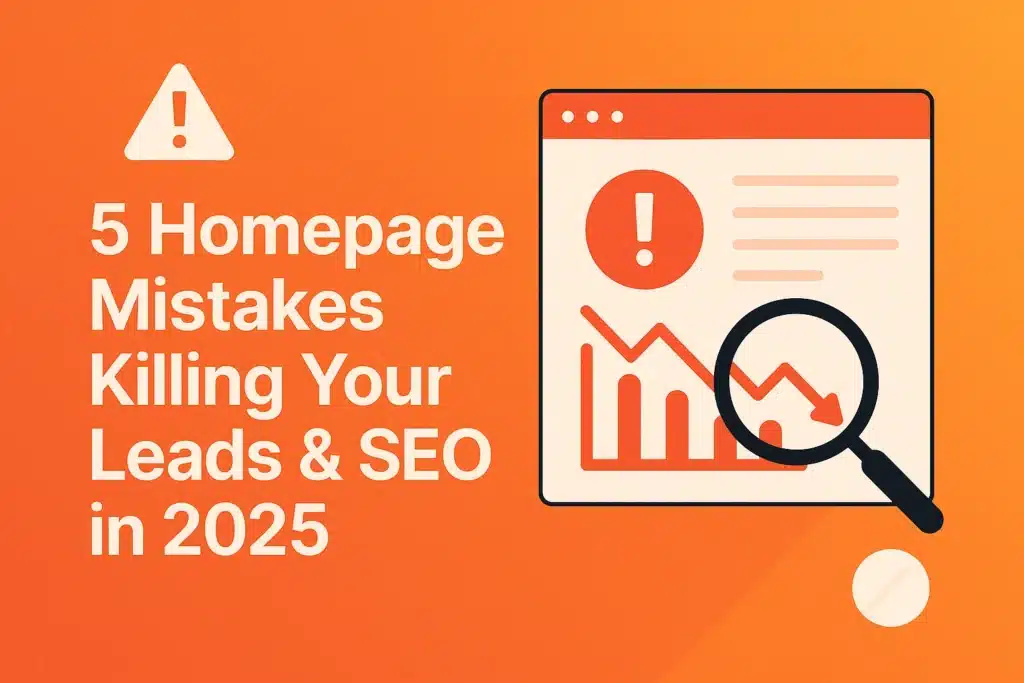Your homepage is the most expensive real estate on your site—yet most service businesses turn it into a revenue leak. A 2025 study shows 78 % of visitors bounce if they can’t grasp your offer in eight seconds (Source: Nielsen Norman). Below are the five fatal errors we see during every UX audit and how to fix them in less than a sprint.
Mistake #1: No Clear Value Proposition Above the Fold

When visitors land, they scan the hero area to answer one question: “Why should I care?” Without a concise headline and supporting subhead, bounce rates soar by 20 %.
Why it hurts:
- Google’s INP rewards fast clarity—if users hesitate, dwell time drops.
- In B2B, unclear messaging reduces form submissions by up to 34 % (HubSpot, 2025).
Quick fix
- Craft a one-sentence “promise + outcome” headline (“We build ADA-compliant sites that load in <1 s”).
- Add a supportive subline with social proof.
- Test placement with scroll-depth analytics.
Considering a hero rewrite? Our web-design team specialises in copy + layout sprints.
Mistake #2: Slow Hero Images Tanking INP Scores
Large, unoptimised hero images are the #1 culprit behind poor Interaction-to-Next-Paint scores introduced in March 2025. Sites with INP > 200 ms lose an average 0.7 Google positions (HTTP Archive, 2025).
Why it hurts
- INP is now part of Core Web Vitals—slow heroes drag rankings and ads Quality Scores.
- Mobile users on 4G abandon pages that take >2.5 s to become interactive.
Quick fix
- Convert hero assets to AVIF or JPEG-XL.
- Add preload hints for the first viewport image.
- Serve images from a CDN and use content-visibility: auto.
Need a deeper performance overhaul? Check our page-speed optimisation service.
Mistake #3: Vague or Confusing CTA Buttons
Generic CTAs like “Submit” or “Learn More” create friction. 73 % of users prefer buttons that state an explicit benefit (CXL, 2024).
Why it hurts
- Vague microcopy lowers click-through by up to 45 %.
- Misaligned colours blend into the design, especially for colour-blind users under WCAG 2.2.
Quick fix
- Use first-person benefit phrases: “Get My Free Audit,” “Book a 30-min Strategy Call.”
- Apply a high-contrast brand colour not used elsewhere on the page.
- Place your primary CTA above the first scroll breakpoint and repeat in the footer.
Mistake #4: Overloaded or Misleading Navigation
A 2025 Baymard study found that sites with more than seven top-nav items see 12 % higher bounce rates.
Here’s your final FAQ set rewritten in clear, reader-friendly blog format consistent with the previous sections:
What is the most important part of a homepage?
Your above-the-fold value proposition and primary call-to-action (CTA) are the most crucial. They quickly tell users what you offer—and encourage them to take action right away.
How often should I update my homepage?
A good rule of thumb is to review it quarterly. Update whenever your:
- Offer changes
- Target audience shifts
- Google’s Core Web Vitals benchmarks are updated
Should my homepage target keywords or users?
Both.
- Use your H1 and H2 tags to target high-intent keywords
- Write your body content for human visitors—addressing real pain points and motivations
If you want, I can now stitch together all four FAQ groups into one polished blog post, complete with an intro, outro, and internal links for SEO. Would you like that?
Why it hurts
- Users feel choice paralysis; crawlers get mixed signals about topical hierarchy.
- Bloated nav pushes content below the fold, hurting LCP.
Quick fix
- Limit the top bar to 5–7 items, group secondary links in a mega-menu.
- Add a sticky scroll-up header that appears only after 100 px scroll.
- Use breadcrumb schema to help Google understand structure.
Thinking bigger than menu tweaks? Our website-redesign specialists can restructure your IA in two weeks.
Mistake #5: Ignoring Schema, Accessibility & WCAG 2.2
Search engines and assistive tech rely on machine-readable cues. Sites lacking FAQ or Service schema miss out on rich-result CTR boosts, while WCAG lawsuits are up 26 % YoY (UsableNet, 2025).
Why it hurts
- Unlabelled buttons reduce screen-reader engagement by 40 %.
- Missing schema lowers the chance of a featured snippet by 20 %.
Quick fix
- Add JSON-LD for FAQ, Product/Service, and Breadcrumb.
- Use colour-contrast checkers (aim for 4.5:1 ratio).
- Ensure all interactive elements are keyboard-navigable.
Quick Fix Checklist: Your 60-Minute Homepage Audit
| # | Audit Item | Pass/Fail | Action |
| 1 | Clear value prop within first 300 px | ☐ | Rewrite headline & subhead |
| 2 | Hero image ≤ 150 KB & in AVIF/JPEG-XL | ☐ | Compress + preload |
| 3 | Primary CTA states benefit & contrasts | ☐ | Update copy & colour |
| 4 | Top nav ≤ 7 items, breadcrumb schema | ☐ | Prune & mark-up |
| 5 | WCAG 2.2 AA colour contrast met | ☐ | Adjust palette |
FAQ:
What is the most important part of a homepage?
Your above-the-fold value proposition and primary call-to-action (CTA) are the most crucial. They quickly tell users what you offer—and encourage them to take action right away.
How often should I update my homepage?
A good rule of thumb is to review it quarterly. Update whenever your:
- Offer changes
- Target audience shifts
- Google’s Core Web Vitals benchmarks are updated
Should my homepage target keywords or users?
Both.
- Use your H1 and H2 tags to target high-intent keywords
- Write your body content for human visitors—addressing real pain points and motivations


